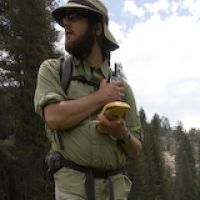Lucas & Conklin, 2013
Montane meadows and hydrologic connections between forests and streams in the Sierra Nevada, California.
Lucas, R.G., and M.H. Conklin (2013)
American Geophysical Union, Fall Meeting 2013, abstract #H43K-01
-
Sierra, GRAD STUDENT
-
Sierra, INVESTIGATOR
Abstract
Montane meadows of the Sierra Nevada often serve as the interface between up-gradient forested area and down-gradient streamflow. We investigated the roles that meadow groundwater and evapotranspiration play in the greater catchment water cycle using a water-column data from monitoring wells and piezometers in two meadows for water years 2008-2012. Analyses include mass balance and modeling using 1-D HYDRUS. Though spatially heterogeneous, groundwater fluxes contribute to evapotranspiration (ETg) across the meadows, and are constrained by surface-water discharge. Near the meadow center groundwater discharges occur for the duration of the snow-free season, ET¬g is relatively low. At the meadow edge the groundwater flux changes from discharge to recharge when the growing season begins; also ETg increases, and major-ion concentrations in groundwater are more dilute than those near the meadow center. When groundwater is discharged throughout the meadow during snowmelt, the stream-water ion content more closely resembles water sampled from wells at the meadow edge. These trends change as the summer season progresses--groundwater is no longer discharged at the meadow edge and the stream water ion concentration matches the groundwater sampled from the center of the meadow. Slug tests performed in the monitoring wells indicate a saturated hydraulic conductivity (Kh) of meadow substrates between 10-5 and 10-6 m s-1. The upper end of this range reflects substrate with large sand fractions, while lower values reflect finer-grained or higher-organic-content substrate. Applying the higher Kh values to groundwater gradients during snowmelt results in groundwater discharge rates greater than streamflow measured at the meadow outlet. This suggests that the peat layer at the meadow surface, with significantly lower Kh values, retards groundwater discharge from the meadow during snowmelt. ETg signals in wells at the meadow edge and in wells installed just outside of the meadow boundary track each other well and continue to exhibit an ETg signal after the meadow vegetation senesces--this suggests that the groundwater table fluctuations at the meadow edge are influenced by ET from the adjacent forest. Being a significant groundwater-discharge location for a montane catchment, meadow processes capture both the ET and groundwater-surface water interactions of the catchment.
Citation
Lucas, R.G., and M.H. Conklin (2013): Montane meadows and hydrologic connections between forests and streams in the Sierra Nevada, California. American Geophysical Union, Fall Meeting 2013, abstract #H43K-01.
 This Paper/Book acknowledges NSF CZO grant support.
This Paper/Book acknowledges NSF CZO grant support.
Explore Further


